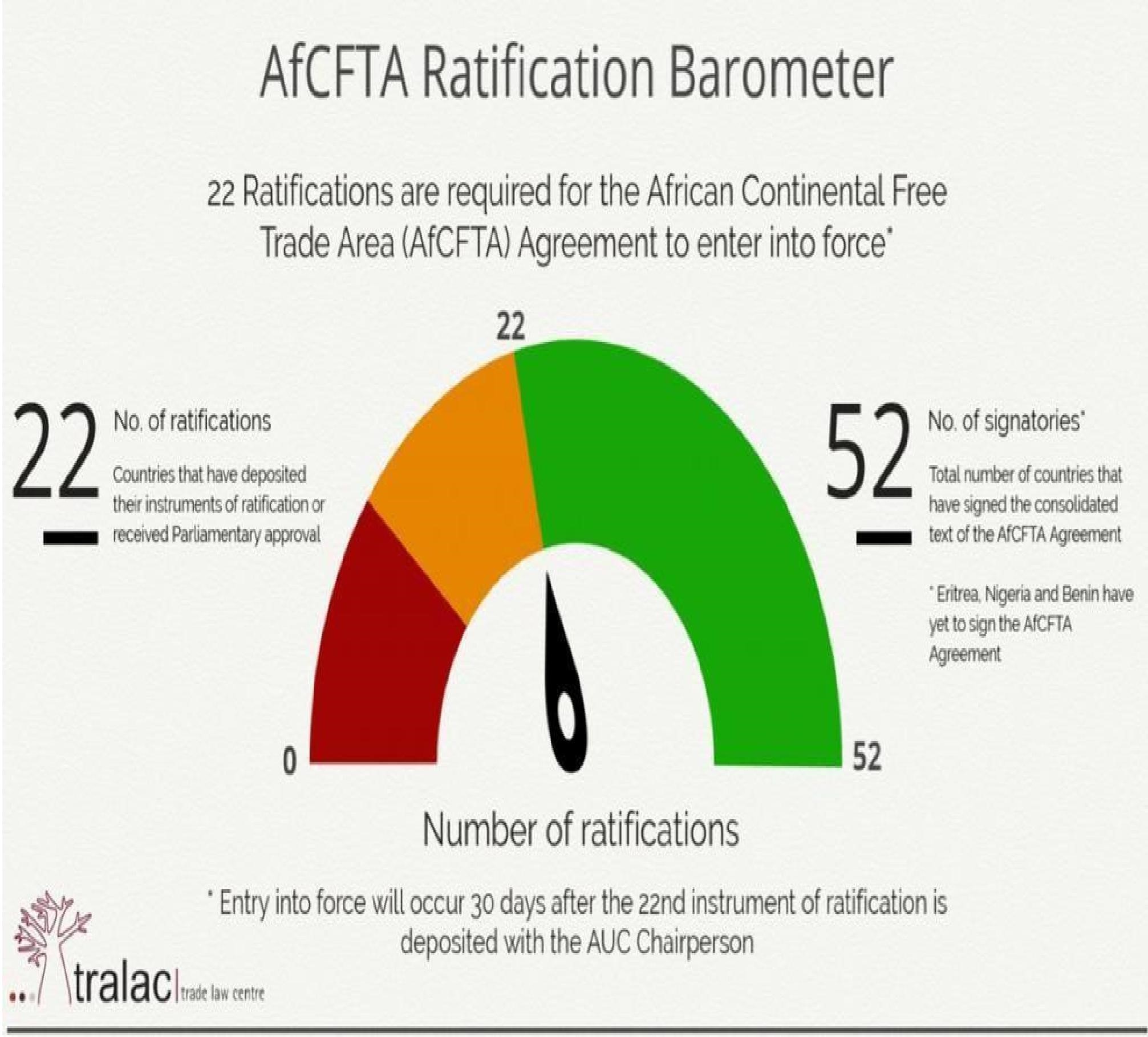The Africa Continental Free Trade Area (AfCFTA)
Preamble
A continental market for all Africans is in the offing following the establishment of the African Continental Free Trade Area (AfCFTA) facilitated by the African Union (AU). The signing of the Continental Free Trade Agreement (AfCFTA) by African countries is a momentous decision which will alter the economic growth trajectory of the continent and allow it to play a greater role in the global economy. The AfCFTA is poised to bring together all the existing eight Regional Economic Communities (RECs) under one continental trading block. AfCFTA is a radical transformation of the African Continent. It is hoped that the benefits of regionalization will accrue to member countries and Kenya in particular as a result of AfCFTA.
Background on AfCFTA
The idea to form a single continental trading block has been in the offing for quite a while. However, during the 18th Ordinary Session of the Assembly of Heads of State and Government of the African Union, held in Addis Ababa, Ethiopia in January 2012, adopted a decision to establish a Continental Free Trade Area (CFTA) by an indicative date of 2017. The Summit also endorsed an Action Plan to Boost Intra-Africa Trade (BIAT) through seven clusters: trade policy, trade facilitation, productive capacity, trade-related infrastructure, trade finance, trade information, and factor market integration as key areas that would facilitate and transform the African Continent.
The Agreement Establishing the AfCFTA was finally adopted at the extraordinary Session of the Assembly of Heads of State and Government of the African Union held in Kigali on 21st March, 2018. The duly signed AfCFTA agreement is the overarching legal instrument establishing the regional integration entity in Africa. The agreement has so far been signed and sealed by 52 Countries in Africa, with three Countries namely Benin, Eritrea and Nigeria yet to sign. After signing the agreement, Kenya followed by ratifying the agreement on the 6th May, 2018 and deposited the instrument at the AU on the 10th May, 2018.

The AfCFTA to take effect required a mandatory threshold of 22 Countries to ratify the agreement out of 52 Countries which had signed the agreement. The Gambia is the number twenty-second Country to ratify the AfCFTA agreement on the 2nd April, 2019. To date, 15 countries have deposited their instruments of AfCFTA ratification with the AU. The remaining 7 countries including The Gambia have received parliamentary approval ratifying the agreement, but are yet to deposit instruments with the AU. The AU has set 1st July 2019 for the AfCFTA to take effect, thereby giving the 7 Countries which have ratified the agreement to deposit their instruments with the AU. This additional time frame will allow the AU to work on modalities of effecting AfCFTA. It was expected that the FTA would come into effect after 30 days after ratification by 22 Countries.
Vision to reality
Africa Continental Free Trade Area (AfCFTA), is a vision of the founding fathers of the Continent of Africa. The founding fathers had a vision of a united Africa in terms of trade which is soon becoming a reality. In the African context, the establishment of a Continental regional integration is
hailed for its anticipated economic transformation and sustained socio-economic development potential. On one hand, it is hailed as a development strategy aimed at aggregating Africa’s small countries and Regional Economic Communities (RECs) into one large market that can deliver economies of scale, improved competitiveness, foreign direct investment (FDI) and poverty reduction, while on the other hand, regional integration is fronted as vehicle which will assist in addressing non-economic problems such as recurring conflicts and political instability as well as increasing the continent’s bargaining power at the multilateral front.
Current Challenges in Africa
- Low Intra Continental Trade
Currently, Africa’s intra-regional trade lies well below that of other regions. In the year 2016, intraAfrican exports constituted only 18 percent of total exports, compared to 59 and 69 percent for intra-Asia and intra-Europe exports, respectively. This is almost similarly replicated in respect of intra-African imports.
Although there have been slight improvements in the past 10 years, with the share of African countries’ exports within the continent having slightly increased, the share of imports, on the other hand, have remained stagnant, despite the increase in total import volume. It is noted that 62% of Africa’s exports in the year 2016 were primary products and 71% of its imports were manufactured products. This prevailing scenario has seen a consistent registering of Continental trade deficit. The deficit occurs when the value of imports exceeds vthe alue of exports. This therefore, means that the African continent has been recording a shortfall or incurring losses in the global business transactions.
- Multiple Regional Economic Communities (RECs)
There are currently eight Regional Economic Communities (RECs) in Africa. These includes the East African Community (EAC), South African Development Community (SADC) among others. Trade between intra-regional economic communities has not been smooth as fa ree trade area is basically confined within the membership of specific RECs. The different RECs have varying tariff and non-tariff barriers to trade which are only favourable to member states but not to parties who are not members of a particular REC. The intra-RECs trade, has overtime been adversely affected by high tariff and Non-Tariff Barriers (NTBs). There’s exists minimal cooperation between Customs authorities between different RECs, though a notable cooperation between Customs authorities within members of the same REC exits. There exists no uniformity or harmonization in product standards and regulations, as well as trade transit and facilitation for all African Countries.
- African Countries at different levels of development
The Countries that comprise of Africa are at different levels of development and classification as captured in the United Nations Development Programme (UNDP) Human Development Index (HDI) which has made uniformity and harmonization of African issues difficult. This has only promoted the go-it-alone attitude among African Countries or within a regional economic community which has been to the detriment of development as a Continent. Africa has always found it hard to forge a common position when engaging at the global stage such as the World Trade Organization (WTO). Through establishment of AfCFTA, Africa will be able to forge a common united position at the world stage and gain greater bargaining power at the global stage for the benefit of her people.
Advantages of AfCFTA
With the coming to effect of the AfCFTA on 1st July, 2019, it is hoped that it will confer benefits to member countries and the African Continent as here below:-
- Increased trade: It is estimated that intra-African trade will increase by at least 52% over the next five years.
- Improved negotiation power: A continental market of more than 1.2bn people with a combined GDP of $2.2 trillion is a far stronger bulwark against limiting external trade forces, than tiny countries that inevitably get overwhelmed in negotiations with big countries and stand-alone economies like the US, Britain and China.
- A single Continental Market: One of the objectives of the AfCFTA is to create a single continental market for goods and services, with free movement of business persons and investments, and thus pave way for accelerating the establishment of the Customs Union.
- Harmonization and Facilitation of Trade: It will expand intra-African trade through better harmonization and coordination of trade liberalization and facilitation instruments across the RECs and across Africa in general.
- Enhanced Competitiveness: The AfCFTA is expected to enhance competitiveness at the industry and enterprise level through exploitation of opportunities for scale production, continental market access and better reallocation of resources. A key objective of the AfCFTA is to boost intraAfrican trade.
- Continental Single Legal and Standards regime: AfCFTA is designed to forge a single continental legal regime for all relevant trade disciplines. This will include lower tariffs, simplified rules of origin and customs procedures, regulations for trade in services and remedies available to affected private parties. This is a bold vison that is vital for advancing Africa’s economic development and capacity to integrate more effectively into the 21st century global economy.
World’s Largest Free Trade Area
Africa with an estimated population of 1.22 billion people is the second most populated continent after Asia with an estimated population of 4.46 billion as per 2016 estimates will position AfCFTA as the world’s largest free trade area since the formation of the World Trade Organization with a highly dynamic market. The population of Africa is projected to reach 2.5 billion by 2050, at which point it will comprise 26 per cent of what is projected to be the world’s working age population, with an economy that is estimated to grow twice as rapidly as that of the developed world.
In terms of numbers of participating countries, Consolidating this continent into one trade area provides great opportunities for trading enterprises, businesses and consumers across Africa and the chance to support sustainable development in the world’s least developed region. United Nations Economic Commission for Africa (UNECA) estimates that AfCFTA has the potential to boost intra-African trade by 52 per cent by eliminating import duties, and double trade if non-tariff barriers are reduced or moderated.
Anticipated benefits of AfCFTA to Kenyans
Kenyan businesses, traders and consumers will no longer pay differential high tariffs on a large variety of goods that they’ll trade between African countries; traders will no longer be constrained by excessive Non-Tariff Barriers (NTBs) including overly burdensome customs procedures and
excessive paperwork due to the coming into effect of AfCFTA which will harmonize and establish a continental uniform tariff and NTBs.
It is envisaged that there will be cooperation between customs authorities at the continental level and established product standards and regulations which cuts across Africa. Trade transit and facilitation, will make it easier for goods to flow between Kenya and other countries in Africa borders. Through the progressive liberalization of services, service suppliers will have access to markets in all African countries on terms no less favourable than domestic service suppliers. Mutual recognition of standards, licensing and certification of service suppliers will make it easier for businesses and individuals to satisfy the regulatory requirements of operating in each other’s markets; The easing of trade between African countries will facilitate the establishment of regional value chains in which inputs are sourced from different African countries to add value to products before exporting externally curtesy of AfCFTA.
However, to protect against unanticipated trade surges, State Parties will have recourse to trade remedies to ensure that domestic industries are safeguarded. It is envisaged that, there’ll be in place a dispute settlement mechanism which will provide a rule-based avenue for the resolution of any disputes that may arise between State Parties or Countries in the application of the agreement. There’s set to be a conducive environment for recognizing African intellectual property rights, facilitating intra-African investment, and addressing anti-competitive challenges. Kenya’s traders and the Micro, Small and Medium Enterprises (MSMEs) in particular needs to strategize on how to take advantages associated with the coming into effect of the AfCFTA on 1st July, 2019.
Anticipated benefits of AfCFTA to Kenya’s MSMEs
The importance of the Micro, Small and Medium Enterprises (MSMEs) in Kenya cannot be understated. A recent National Economic Survey report by the Central Bank of Kenya (CBK) indicate that SMEs constitute 98 percent of all business in Kenya , create 30 percent of jobs annually as well as contribute 3 percent to the GDP.
The MSMEs in Africa and Kenya in particular stand to benefit from the establishment of AfCFTA. The MSMEs are key to growth in Kenya and the continent of Africa. MSMEs businesses struggle to penetrate more advanced overseas markets, but are well positioned to tap into regional export destinations and will be able to use AfCFTA to access Africa’s regional market as a stepping stone to expand or graduate to overseas markets. The MSMEs further stand to benefit through AfCFTA by finding it easy to supply inputs to larger regional companies or manufacturers, who then export their final products. An example is of a current scenario in which South Africa’s large automobile manufacturer’s source inputs such as leather for seats from Botswana and fabrics from Lesotho. Sourcing of these inputs are geared to expand to other countries in Africa, thereby supporting MSMEs in Africa.
Proposed policy interventions for Kenyan’s to take advantage of AfCFTA
- There’s need to undertake an in-depth review of existing competitive enhancing policies to improve competitiveness of Kenya’s goods and services with other countries in Africa in readiness for the AfCFTA.
- Kenya’s entrepreneurs should plan for potential increased demand for goods and services and therefore, strategize to increase production and diversify products and services in order to take
advantage of the soon to be effected AfCFTA encompassing a total population of over 1.2bn people.
- There’s a likelihood to incur losses in terms of revenue as a result of AfCFTA as the whole of Africa will be a free trade area. Appropriate policies therefore, needs to be formulated to cushion any losses in revenue that may occur.
- Arising from the fact that Africa’s dominant trade is on commodities and agricultural products, it’s important to allocate time and resources in upscaling manufacturing (One of the big 4 Agenda of the Government) and value addition to take advantage of the existing gap among African Countries.
- There is need to strategize on how to compete with products and services from well-established economies such as the Republic of South Africa, Egypt or else face flooding of products and services from these economies which will destroy Kenya’s infant industries.
Conclusion
Realization of the vision of having a continental wide free market through AfCFTA is a welcome gesture. Africans need to exploit the opportunity being availed through AfCFTA by increasing intraAfrica trade, improving on the quality and standards of products and services, and improve competitiveness with the other world economies. Kenya has taken a leadership role in the establishment of the AfCFTA but need to urgently review policies with the objective of enhancing competitiveness and facilitate the Private Sector to reap the benefits of an enlarged free market and be ready to compete with other African states in the scramble for trade opportunities



